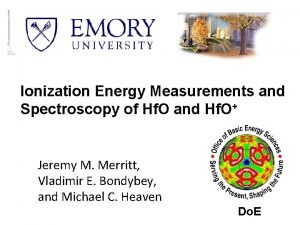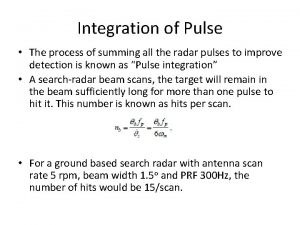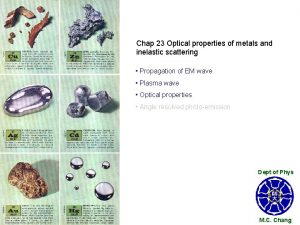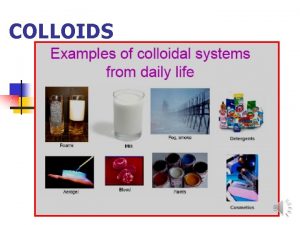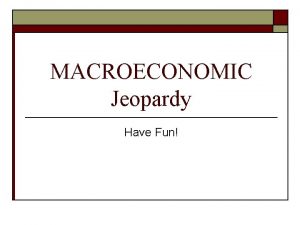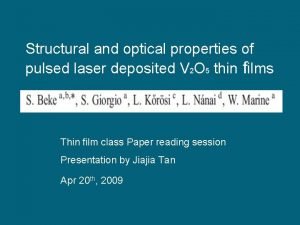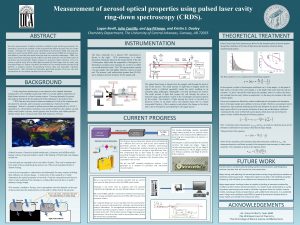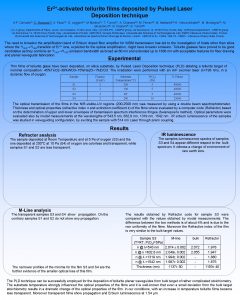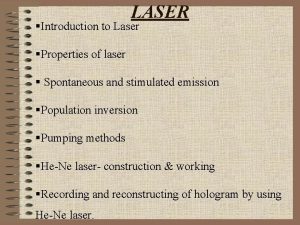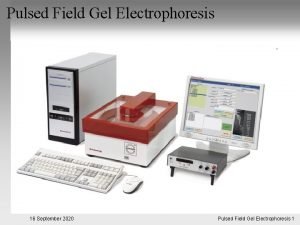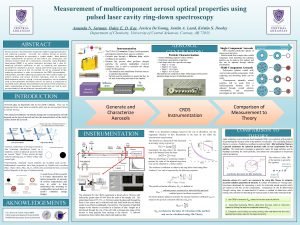Structural and optical properties of pulsed laser deposited












- Slides: 12

Structural and optical properties of pulsed laser deposited V 2 O 5 thin films Thin film class Paper reading session Presentation by Jiajia Tan Apr 20 th, 2009

Outline Application of V 2 O 5 Research Motivation and objective Experimental procedure PLD Characterization 1. XRD 2. XPS 3. Transmittance measurement 4. TEM Important results Conclusions

Application Mainly: Optical switching devices Electrochromic devices Cathodes materials for Li Battaries Structure: Orthorhombic unit cell Layer-like structure

Motivation Vanadium oxide is a good catalyst, especially when its size reaches nanoscale. ---> The formation of nanoclusters. Objective V 2 O 5 thin films deposited by PLD on amorphous glass at 13. 33 Pa and 220℃ at various laser fluence and pulse numbers.

Experiment procedure: PLD Target: 1, Hhigh purity V 2 O 3 powders are pressed to pallets; 2, V 2 O 3 changes to V 2 O 5 after annealed at 550℃ in air for 24 h. Laser parameters: *Pulsed Ar. F excimer laser (λ=193 nm, pulse duration 15 ns at FWHM) at a fluence level of 0. 9– 2. 7 J/cm 2. *Repetition rate was 2 Hz.

Experimental conditions

Important results The size of NCs is in the range of 2– 40 nm. From experimental results it is evident that NC size depends on the laser fluence used during deposition.

T decreases at higher frequency. The optical band gap is about 2. 52 e. V.

Eg (film) = 2. 52 e. V > Eg (bulk) =2. 25 e. V. Why? Quantum confinement effect give rise to the energy gap In the range of 2– 40 nm.

Conclusion Structure: Range from 2– 40 nm. NC size can be selected by adjusting the laser fluence. Optical properties: Aabsorption edge is about 2. 52 e. V. Bohr radius is calculated to 4. 52 nm.


Bohr radius: The physical properties change due to quantum confinement that results from electrons and holes being squeezed into a dimension that approaches a critical quantum measurement, called the exciton Bohr radius.
 Pulsed electric field
Pulsed electric field Pulsemaster pulsed electric field
Pulsemaster pulsed electric field Pulsed coherent radar
Pulsed coherent radar Optical properties of metals and nonmetals
Optical properties of metals and nonmetals Kinetic properties of colloids
Kinetic properties of colloids John's parents deposited $1000
John's parents deposited $1000 Point bars are deposited
Point bars are deposited P x r x t
P x r x t Sathya deposited rs 6000
Sathya deposited rs 6000 The yellowish fertile soil deposited along riverbanks
The yellowish fertile soil deposited along riverbanks John's parents deposited $1000
John's parents deposited $1000 What is deposited
What is deposited The graph below shows the value of a $100 deposited
The graph below shows the value of a $100 deposited
